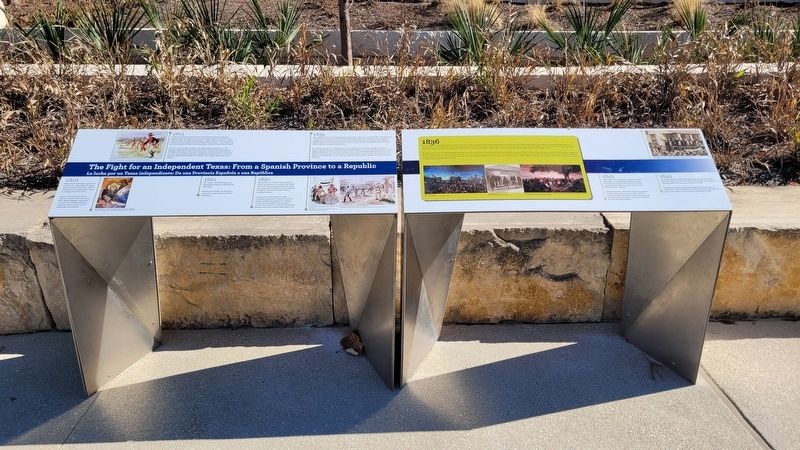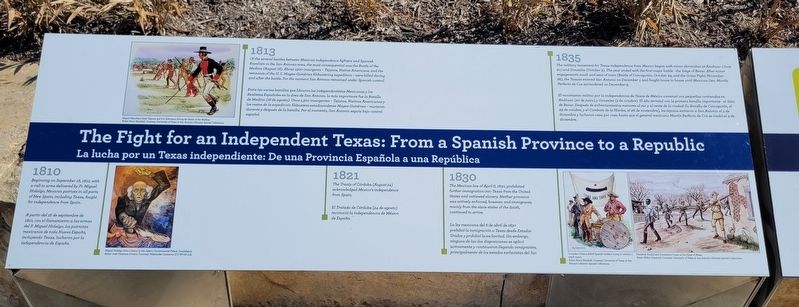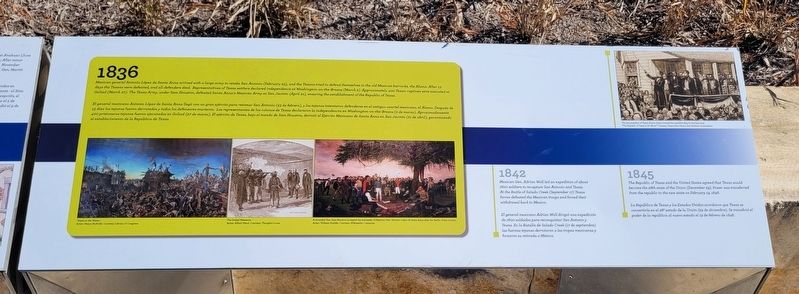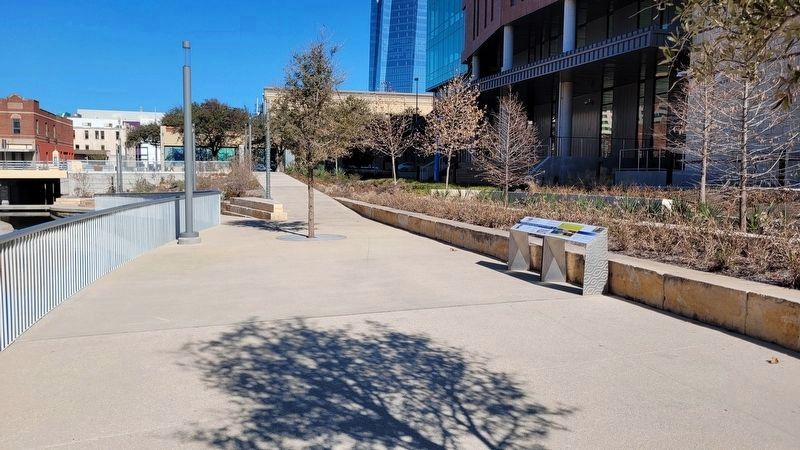Main/Military Plaza in San Antonio in Bexar County, Texas — The American South (West South Central)
The Fight for an Independent Texas: From a Spanish Province to a Republic
Inscription.
1810
Beginning on September 16, 1810, with a call to arms delivered by Fr. Miguel Hidalgo, Mexican patriots in all parts of New Spain, including Texas, fought for independence from Spain.
1813
Of the several battles between Mexican independence fighters and Spanish Royalists in the San Antonio area, the most consequential was the Battle of the Medina (August 18). About 1900 insurgents - Tejanos, Native Americans, and the remnants of the US Magee-Gutierrez filibustering expedition were killed during and after the battle. For the moment San Antonio remained under Spanish control.
1821
The Treaty of Córdoba (August 24) acknowledged Mexico's independence from Spain.
1830
The Mexican law of April 6, 1830, prohibited further immigration into Texas from the United States and outlawed slavery. Neither provision was actively enforced, however, and immigrants, mainly from the slave states of the South, continued to arrive.
1835
The military movement for Texas independence from Mexico began with minor skirmishes at Anahuac (June 20) and Gonzales (October 2). The year ended with the first major battle the Stege of Bexar. After minor engagements south and west of town (Battle of Concepción, October 29, and the Grass Fight, November 26), the Texans entered San Antonio on December 5 and fought house to house until Mexican Gen. Martín Perfecto de Cos surrendered on December 9.
1836
Mexican general Antonio López de Santa Anna arrived with a large army to retake San Antonio (February 23), and the Texans tried to defend themselves in the old Mexican barracks, the Alamo. After 13 days the Texans were defeated, and all defenders died. Representatives of Texas settlers declared independence at Washington-on-the-Brazos (March 2). Approximately 400 Texan captives were executed at Goliad (March 27). The Texas Army, under Sam Houston, defeated Santa Anna's Mexican Army at San Jacinto (April 21), ensuring the establishment of the Republic of Texas.
1842
Mexican Gen. Adrián Woll led an expedition of about 1600 soldiers to recapture San Antonio and Texas. At the Battle of Salado Creek (September 17) Texus forces defeated the Mexican troops and forced their withdrawal back to Mexico.
1845
The Republic of Texas and the United States agreed that Texas would become the 28th state of the Union (December 29). Power was transferred from the republic to the new state
on February 19, 1846.
Captions
1: Miguel Hidalgo from a fresco in the Jalisco Governmental Palace, Guadalajara. Artist: José Clemente Orozco. Courtesy: Wikimedia Commons (CC BY-SA 3.0).
2: Miguel Menchacs leads Tejanos and U.S. filibusters during the Battle of the Medina. Artist: Bruce Marshall. Courtesy: University of Texas at San Antonio Libraries Special Collections.
3: Gonzales citizens defied Spanish soldiers trying to retrieve a small canon. Artist: Bruce Marshall. Courtesy: University of Texas at San Antonio Libraries Special Collections.
4: Hendrick Arnold and Greenberry Logan at the Siege of Bexar. Artist: Milton Emanuel. Courtesy: University of Texas at San Antonio Libraries Special Collection.
5: "Dawn at the Alamo." Artist: Henry McArdle. Courtesy: Library of Congress.
6: The Goliad Massacre. Artist: Alfred Waud. ThoughtCo.com
7: A wounded Gen. Sam Houston accepted the surrender of Mexican Gen. Antonio López de Santa Anna after the Battle of San Jacinto. Artist: William Huddle. Courtesy: Wikimedia Commons.
8: The last president of Texas, Anson Jones, lowered the republic's flag for the final time. "The Republic of Texas is No More", Courtesy: Texas State Library and Archives Commission.
[Spanish Text]
A
partir del 16 de septiembre de 1810, con el llamamiento a las armas del P. Miguel Hidalgo, los patriotas mexicanos de toda Nueva España, incluyendo Texas, lucharon por la independencia de España.
1813
Entre las varias batallas que libraron los independentistas Mexicanos y los Realistas Españoles en la área de San Antonio, la más importante fue la Batalla de Medina (18 de agosto). Unos 1,300 insurgentes - Tejanos, Nativos Americanos y los restos de la expedición filibustera estadounidense Magee-Gutiérrez - murieron durante y después de la batalla. Por el momento, San Antonto seguía bajo control Español.
1821
El Tratado de Córdoba (24 de agosto) reconectó la independencia de México de España.
1830
La ley mexicana del 6 de abril de 1830 prohibió la inmigración a Texas desde Estados Unidos y prohibió la esclavitud. Sin embargo, ninguna de las dos disposiciones se aplicó activamente y continuaron llegando inmigrantes, principalmente de los estados esclavistas del Sur.
1835
El movimiento militar por la independencia de Texas de México comenzó con pequeñas contiendas en Anáhuac (20 de junio) y Gonzales (2 de octubre). El año terminó con la primera batalla importante - el Sitio de Bexar. Después de enfrentamientos menores al sur y al oeste de la ciudad (la Batalla de Concepción, el 29 de octubre, y el
Combate de la Hierba, el 26 de noviembre), los tejanos entraron a San Antondo el 5 de diciembre y lucharon casa por casa hasta que el general mexicano Martín Perfecto de Cos se rindió el 9 de diciembre.
1836
El general mexicano Antonio López de Santa Anna llegó con un gran ejército para retomar San Antonio (23 de febrero), y los tejanos intentaron defenderse en el antiguo cuartel mexicano, el Alamo. Después de 13 días los tejanos fueron derrotados y todos los defensores murieron. Los representantes de los colonos de Texas declararon la independencia en Washington-on-the-Brazos (2 de marzo). Aproximadamente 400 prisioneros tejanos fueron ejecutados en Goliad (27 de marzo). El ejército de Texas, bajo el mando de Sam Houston, derrotó al Ejército Mexicano de Santa Anna en San Jacinto (21 de abril), garantizando el establecimiento de la República de Texas.
1842
El general mexicano Adrián Woll dirigió una expedición de 1600 soldados para reconquistar San Antonio y Texas. En la Batalla de Salado Creek (17 de septiembre) las fuerzas tejanas derrotaron a las tropas mexicanas y forzaron su retirada a México.
1845
La República de Texas y los Estados Unidos acordaron que Texas se convertiría en el 28 estado de la Unión (29 de diciembre). Se transfirió el poder de la república al nuevo estado el 19 de febrero de 1846.
Erected 2022 by San Pedro Creek Cultural Park.
Topics. This historical marker is listed in these topic lists: Colonial Era • Hispanic Americans • War, Texas Independence • Wars, Non-US. A significant historical date for this entry is April 6, 1830.
Location. 29° 25.411′ N, 98° 29.769′ W. Marker is in San Antonio, Texas, in Bexar County. It is in Main/Military Plaza. Marker can be reached from Dolorosa Street, 0.1 miles east of South Laredo Street. The marker is located on the east side of the creek along the the park trail. Touch for map. Marker is at or near this postal address: 506 Dolorosa Street, San Antonio TX 78205, United States of America. Touch for directions.
Other nearby markers. At least 8 other markers are within walking distance of this marker. Urban Renewal and the Expansion of Government Buildings (within shouting distance of this marker); Laredito and the Tale of Two San Antonios (within shouting distance of this marker); Jose Francisco Ruiz (within shouting distance of this marker); Dolorosa Street (about 300 feet away, measured in a direct line); A Poor Settlement Takes Shape at the Northern Frontier of New Spain (about 300 feet away); The Healing Arts West of the Creek (about 300 feet away); Barbed Wire (about 400 feet away); Flood of the Century (about 400 feet away). Touch for a list and map of all markers in San Antonio.
Also see . . .
1. Where beauty meets purpose. San Pedro Creek Culture Park (Submitted on January 23, 2023, by James Hulse of Medina, Texas.)
2. Texas Revolution. Texas State Historical Association
The Texas Revolution began in October 1835 with the battle of Gonzales and ended on April 21, 1836, with the battle of San Jacinto, but earlier clashes between government forces and frontier colonists make it impossible to set dogmatic limits in terms of military battles, cultural misunderstandings, and political differences that were a part of the revolution. The seeds of the conflict were planted during the last years of Spanish rule (1815–21) when Anglo Americans drifted across the Neutral Ground and the eastern bank of the Red River into Spanish territory, squatted on the land, and populated Spanish Texas. More alarming than these illegal residents, who only wanted to "settle and stay," were filibusters such as Philip Nolan, who commandeered portions of Spanish lands for personal gain and political capital. During the fading years of New Spain, its ruling council, the Cortes, worried about securing their far northern frontier and began to encourage foreign immigration to Texas, including Anglo American colonization. One who was eager to take advantage of a change in Spanish policy was Moses Austin, who received a commission from the Spanish governor of Texas to bring 300 families and establish a colony, thereby rebuilding some of his lost fortune associated with the Panic of 1819. Upon his death in 1821, his son and heir Stephen Fuller Austin fulfilled his father's vision and became the first empresario of Texas.(Submitted on January 24, 2023, by James Hulse of Medina, Texas.)
Credits. This page was last revised on February 2, 2023. It was originally submitted on January 23, 2023, by James Hulse of Medina, Texas. This page has been viewed 80 times since then and 12 times this year. Photos: 1, 2, 3, 4. submitted on January 24, 2023, by James Hulse of Medina, Texas.



